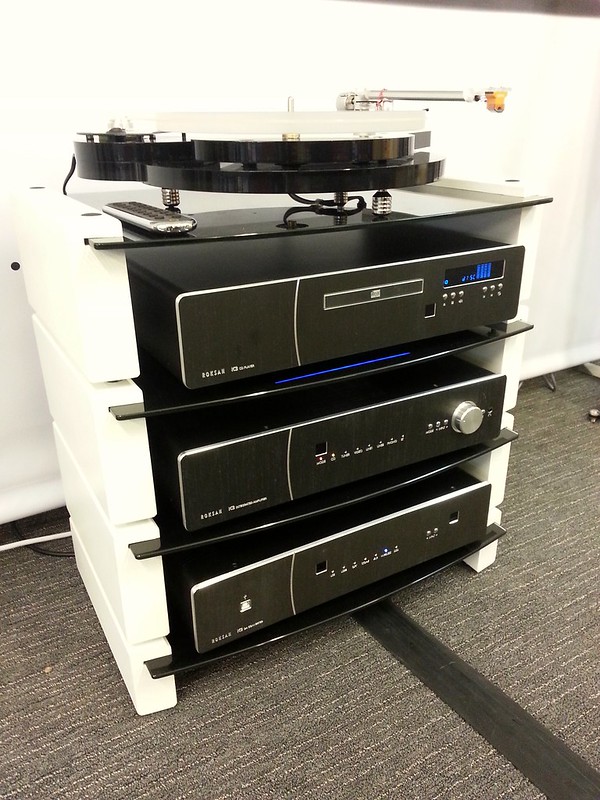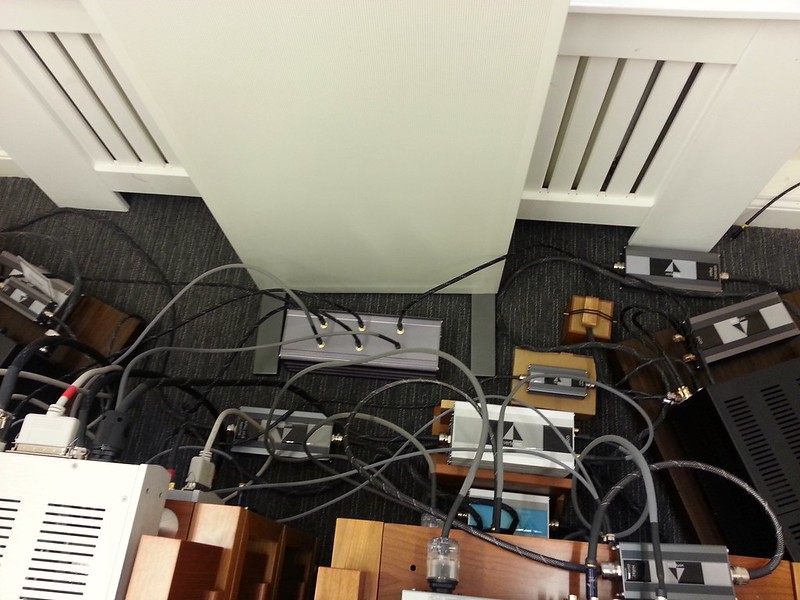A couple of years ago, I thought it might be interesting to compare a bunch of late 70s / early 80s amps against the big "star" of the time, the NAD 3020.
So I collected some examples, over a 6 month period, from Hitachi, JVC, Pioneer and Technics. All good working examples.
I tried them, they all worked and did a reasonably good job, but the idea of reviewing them and comparing them to the NAD really wasn't worth the effort of writing it all up. It would've really just been a feature count of the shiny amps and ranking them in positions 6 to 10 for sound quality. The NAD would've occupied positions 1 to 5.
At the time, when I bought my first amp (which was a NAD 3020), I listened to it against a Technics and a JVC (in one shop) and chose the NAD (auditioned and purchased from another shop). Because these were separate listening sessions, all I knew was that I liked the NAD better, but didn't really have the chance for a back to back comparison. Collecting them now and listening just showed how big a gulf there was been the mainstream feature count amps of the time and the NAD. OK, age may have affected them in various degrees, but its the consistency of the mainstream amps' peformances - polite, a little slow, ill-defined bass lines, rolled-off top end etc., contrasted to the bouncy, enjoyable, tuneful bass of the NAD that is so starkly better.
However, gotta say that I liked the trad VU meters on the Hitachi HA-3500, the sophisticated looking flourescent VU meters on the Technics SU-V3 and the brash blue VUs on the Pioneer SA-610. They're not much use, but they nearly swayed a naive 16 year old buyer, until they played music, when the NAD won the hard earned Saturday job money! The NAD still looks dull and a bit cheap though.
So, some of the collection is up for sale in the next few posts. They'll be good for the study, kitchen, garage, kids room etc., to provide background music, but not for really enjoying listening to music. For that, choose a NAD - but it'll cost you 3x as much now, as NAD amps fetch more than they cost new...
"What a refreshingly honest blog about listening to music through hi-fi. So happy to see views based upon the enjoyment of music rather than so-called sound 'quality'." - Peter Comeau, Director of Acoustic Design at Mission / Wharfedale
Monday 28 September 2015
Thursday 24 September 2015
Linn Factory Customer Event - Series 5 and More Exaktitude
Having launched the
new “lifestyle” series 5 range of speakers in a suitably “lifestyle” location –
The Violin Factory in London - a couple of weeks ago, Linn kindly arranged a
factory event for their more traditional customers. How far do people travel for such an
event? Well I think Vancouver was the
furthest that I know of, so clearly there’s something worth going to Glasgow to
see and hear.
The launch of series 5
has, predictably, caused some debate on the Linn forum about the company’s
focus and direction. Gilad Tiefenbrun’s
presentation(he’s the Linn MD) at the event made it very clear that series 5 is
supplementary to their traditional product range, not a replacement – hence the
naming doesn’t sit in the traditional hierarchy. Within the more traditional range, it’s also
become very clear that the company has bet the future on more and more
integrated solutions – starting with DS/Pre-amp and Exakt built into power amps
and fully integrated Exakt / amp / speaker offerings. There was no mention of more traditional
analogue active either – something that quietly disappeared from integrated
speakers (such as Akubarik and 350A) with the most recent product launches, but
still an option inside Majik and Akurate power amps.
After a successful
night-before-get-together of forum members back at the 40th
Anniversary event in 2013, we again gathered at the Counting House to discuss
the latest products, speculate on the next day’s activities and generally not
take things too seriously. The forum has
been awash with lifestyle product speculation of late, and here, the truth was revealed
with the latest in Linn accessories – the Tea Kloth, exclusive for Forum GTG
members. I don’t think we’ll be seeing a full production run…
INTRODUCTIONS
So what of the event itself? Well, this was extremely well organised,
clearly thought through, and focussed more on the non-lifestyle products,
concentrating on the latest thinking with Exakt and the new Exaktboxes in the
Akurate and Majik ranges. Linn laid on a
coach from Glasgow city centre out to the factory at Waterfoot. I guess a total of about 80 to 90 customers
attended the event. The local dealer was
present, but this was very much a customer event. We kicked off with a buffet lunch at the back
of the ballroom, then gathered for the initial presentations. Gilad welcomed us all and talked about the
new products and how they’re focussed on bringing people into considering a
quality music system for their home, in circumstances where large and more
functional looking equipment is not thought to be acceptable in the home. He spoke about how buyers are now buying as
couples with joint input and how Linn wanted to give them a simple solution
that worked with multiple different interior décor situations. More on the technicalities behind the series
5 speakers below. He referred to the
ever evolving capabilities of Exakt and how it has been an enabler for series
5, for more domestically acceptable speaker positions and every increasing performance
in the Linn range. In addition to Majik
Exaktbox-I, the new Akurate Exaktbox 6 and Exaktbox Sub, Linn are bringing
phase aligned benefits to owners of Linn speakers over 20 years old, thereby
upgrading legacy kit, something other manufacturers don’t offer.
Next to present was
Keith Robertson – Linn’s chief technical lead.
He talked through the virtues of Exakt and the new products, and how the
development of Exakt algorithms continues apace, with a new software release
later this year that will improve the handling of bass roll-off. Also, the achievement of the engineering team
to get 8 channels of 100W power amps, an Exakt engine and 8 channels of Majik
level DACs into a single integrated Exaktbox-i.
I’ll cover these in the individual demo comments below. Worth noting that all Linn speakers are
measured for Exakt, and have been so for the last 2 years – Majik right up to
Klimax level, in anticipation of owners choosing something Exakt either at
purchase or in the future. So for under
2 year old speaker, there’s Exakt data stored in Linn’s systems, ready to apply
Exakt algorithms specifically tailored for that speaker’s serial number. For pre-Exakt speakers, a “generic” set of
measures are used for the speaker model in question, and this is expected to be
within a less than 5% tolerance – typically around 2 to 3%.
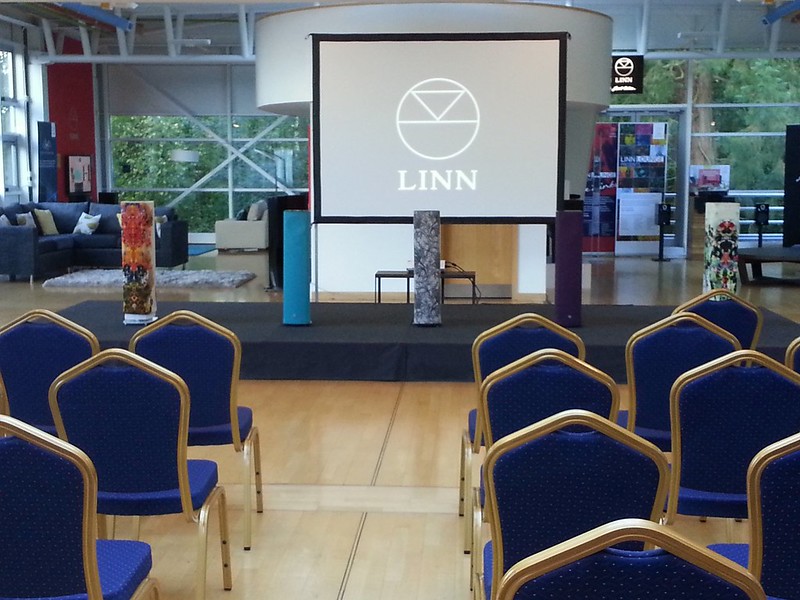 |
| Ballroom and 5x Series 5 |
DEMOS
After the intros, we
were split into 6 groups and then hosted around the various locations around
the factory – this was extremely well organised, timed to fit into the
available slots and offered a good variety of well thought through demos, a
coffee break slotted in part way through the afternoon:
-
Factory
Tour
-
Series 5
-
Akurate /
Klimax Exaktbox & Analogue Active Comparison (and latest thinking on Keltik
Exakt configurations)
-
Exaktbox
Sub
-
Majik
Exaktbox-I vs Majik Passive
DEMOS – Akurate /
Klimax Exaktbox & Analogue Active Comparison (and a bonus for Keltik
owners)
In the back right hand
demo room of Linn Home (a domestic-like environment in a segregated corner of
the factory) we had a 40th Anniversary LP12, Klimax DSM and, a bit
of a surprise this one, a pair of Linn Keltik speakers. Why was this a surprise? Well the Keltik used
to be at the top of the Linn range, but hasn’t been in production for at least
10 years, if not longer. So why are Linn
using a legacy product when inviting customers to a product launch event? Well it’s quite straightforward – they’re
showing that they’re committed to looking after as many of their customers as
possible, by making sure that initial investments can continue to be developed
and new technologies brought to bear.
Here the demo went
through several steps –first using 3x Klimax Twins to drive the Keltiks with
original, analogue Klimax crossovers, using the analogue outputs from the KEDSM. Sounds good – using a 24 bit version of the
theme tune to the Money Programme. We
then get an Akurate Exaktbox version, still using 3x Twins but now the Exakt
outputs from the KDSM. There’s a step
change in focus and timing – it’s pretty convincing. We then step up to the Klimax Exaktbox which
features a higher quality set of DACs and there’s another decent change in
performance.
Many of you will know
that the Keltik uses an isobaric bass system – that is 2 bass drivers, one
behind the other, with the chamber between being sealed. This gives deeper bass from the speaker
without needing massive drivers on a very wide front baffle. The air chamber between the drivers is sealed
so that they act as one. According to
speaker designer Phil Budd, this is what is known within engineering as “an
approximation”. Reality is that a sound
wave passes through the air in the chamber, hitting the back of the front
driver slightly after the front driver has started moving. Exakt now allows for this to be modelled and compensated
for. So the next demo added a further
Klimax Twin power amp so that the bass drivers could be driven independently,
each from their own Exakt DAC channel - which involved adding another Klimax Exaktbox as this is a 6 channel device. It
was a surprise (to me at least) that it added so much more clarity to the rhythm
of the track. It transpired, in the bar
in the evening, that the idea for driving the isobaric drivers separately had
been cooked up by acoustics engineer Phil the day before the event, calculated
and implemented in the morning, then used for the demos in the afternoon. This is an impressive demonstration of the
abilities of Exakt, and the confidence of the Linn team that they’d found a
better solution and successfully implemented it in front of customers. They can sell more amps to customers with
Keltiks too of course…. I expect this
will be coming for original Isobariks, Akubariks and Majik Isobariks in due
course.
DEMOS – Series 5
Moving next door to
the other dem room, we were introduced to the series 5 loudspeakers. Here they are being demonstrated along with
an Akurate DSM – the way they are being marketed and priced, in fact. A little
technical discussion first. The 520 (20
litres internal volume) and 530 (30 litres internal volume) are completely new
loudspeaker designs. They’re built using a laminated construction. Seen on the production line in the factory,
they have a very smooth black satin finish to them, under the covers. They are not designed to be seen or played
without a cover. They use new to Linn
drive units, manufactured elsewhere but to Linn specification. The tweeter is new to Linn and costs
approximately 3x the cost of a 2K array.
It’s in a very shallow waveguide mounted over a very wide iteration of
the scoop that sits behind 2K and 3K arrays seen on other Linn speakers. The mid-bass driver is around 5” and has a
radially cut fibre cone where the cuts are then filled with a damping
compound. Both speakers have these drive
units at the top of the cabinet, with the tweeter below the mid-bass – very
Missionesque. I know that Linn have been
criticised in some quarters in the past for under-investing in the quality of
drive units, so this seems to go some way towards addressing that. The 530 adds a downward firing pair of 6”
drivers in isobaric mode, exiting through the grille / slot at the base of the
cabinet.
The cabinets have very
much rounded corners – this seems to have been driven more by aesthetics rather
than acoustics. The top and base plates
are glass and are available in black, white or mid-grey at the customer’s
choice. Also replaceable later if
required (and Linn still stock them of course).
The covers feature a number of different fabrics from various designer
brands, in addition to Linn’s own Fabrik which has been developed for the
printed versions. Customer defined
prints may become an option at some time in the future. The material is tailored to the speaker and
features a glued in place frame that fits over the mid-bass and tweeter. This allows Linn to stretch the fabric over
this frame to a pre-determined degree, with the glue then holding it in
place. This is to allow for the
acoustics engineers to then compensate for the effect of the fabric on sound
quality – the process making the acoustic properties of the fabric predictable. I do wonder about the acoustic effects of the
cover’s rigid frame which is so close to the drive units.
Each of these speakers
are driven by an integrated Exakt engine / DAC / power amp module that fits into
the rear lower part of the cabinet, hidden under the cloth wrapper. I asked about cooling – apparently the effect
of the cloth on cooling has been allowed for.
I guess with Linn’s SMPS and cool running Chakra amps, it’s not a big
challenge anyway. Each driver in the
speakers has an amp and DAC dedicated to it, rated at 100W. The amp and DAC are “based on Majik” level
products. Not sure if the 530 has one or
2 amps per isobaric woofer, I didn’t ask, but I suspect just the one.
We started with the
520 – which is quite dinky – a bit smaller than a Keilidh. They look OK – the VPL of the driver frame is
very cloth dependent – sometimes it’s obvious (plain, lighter colour fabrics),
sometimes pretty much invisible (heavily patterned, darker coloured
fabrics). I said on the forum that I
didn’t like it at all in the photos, but it’s less offensive “in the cloth”. As for sound, well I don’t think Linn have
thrown the baby out with the bath water, but for £9k with the streamer, I would
say that this was a bit underwhelming.
There is a caveat though – well, a couple really – I don’t like Linn’s
dem rooms, they’re a bit dead sounding, and this is a big room for such dinky
speakers to fill. I did get the
impression that I’d rather have a Naim SuperUniti and a pair of Focal 928s
though. It was all a bit lightweight
which over-emphasised the top end too.
In came the 530, which
is still a very slim and compact speaker.
But this is a much more serious sounding speaker. No doubt set up with all the Exaktness
sorted, room optimisation dialled-in etc. it performed very well. The fuller bass really balanced that top end
nicely. And that bass is very well
controlled, nicely articulated and not over-blown like the Majik Isobarik can
be. I think this speaker could stand
comparison against my own analogue active Majik 140s, it would certainly be an
interesting back-to-back to test out. A
bit more on this later though, because the Majik 140s featured later too. Both 520 and 530 had been placed in what Linn
considers the ideal position for these speakers in this dem room – which seemed
to be pretty much identical for both of them – this makes some sense, as the
530’s additional bass output comes out from the base of the cabinet and as such
probably doesn’t interact with the rear wall any more than the sides.
 |
| 520 |
DEMOS – Exaktbox Sub
There’s a very large
room in Linn Home – one that the largest Linn speakers, the 350s, can just
about cope with if turned up a fair way.
So Linn chose to demonstrate their current top of the the range
standmount in here, the Akudorik Exakt.
Are they mad? Quite possibly, but
not based on this demo. Some music was
played and the Akudorik did their thing – which is to sound detailed with
decent drive and timing, but I can’t really envisage these at home, trying to
bang out some electronic dance music. No.
But that was the
point. The usual solution to this is to
(other than buying decent floorstanders in the first place) add a
subwoofer. This was done at this point,
but in such a way that demonstrated the effects of bass from a subwoofer
arriving at the listening position, out of time or out of phase (or both), with
the music. And that effect was obvious. The bass was fuller, but was a bit tuneless,
lumpy over the frequency range and slightly out of time with the rest of the
tune. Exakt was then applied using the
Exaktbox Sub (for which you have to measure the subwoofer’s position in the
room) so that the subwoofer’s output arrived both time and phase aligned at the
listening seat. This was a vast
improvement and joined the bass up to the rest of the tune. But the little 226 sub really wasn’t enough
for the massive room. So a second sub,
positioned underneath the very long dining table and a good 5 metres behind the
listening position was added – time and phase aligned of course. At this point the bass really did suit the
room (perhaps a touch too loud for my tastes) but also very well integrated so
that it sounded like this huge amount of bass was coming from the same place as
the rest of the tune. A very impressive
demo. I’m guessing, but just FYI, it
looked like the Akudoriks had been placed in their “ideal” location in the
room, rather than the less obtrusive position that is possible with Exakt
SPACE+ optimisation.
FACTORY TOUR
I’ll not say much
about this, as Linn’s factory, processes, methods etc., have been documented many
times in many places. Not much has
changed in this respect – just the addition of the new cloth / frame stretching
and bonding process, which we didn’t see.
The production line was dominated by series 5 speakers this time –
presumably to build up the dealer network’s demo stocks.
DEMOS – Majik Exaktbox-i
In an unusual move,
Linn set up one of the demos in their R&D inner sanctum – the development
listening room. This has some
interesting room treatment – with what look like absorbent panels on most
walls, but the main speaker positioning area surrounded by hard plastic shapes –
supported out from the wall a couple of inches and angled seemingly and random
angles – this treatment extending a couple of meters or so along the side walls
and ceilings. Perhaps something to do
with first reflection control.
In here we had and
Akurate level LP12 feeding a Majik DSM and a pair of Majik 140 speakers. First up we listened to the turntable and the
streamer using the internal stereo power amps of the Majik DSM. It sounded OK, but not brilliant. The new Majik Exaktbox-I was then added and
it was a revelation. A superb demo of
the benefits of the Exakt technology – much punchier, timing more coherent,
instruments and vocals defined clearly.
The M140s were sounding really great with this Exaktbox. At this point, I was thinking the series 5
530 would really be struggling to keep up with this. The system was then returned back to standard
passive and the change back was equally clear to hear. The difference between standard and Exakt was
much more pronounced on the streamer content than it was with the LP12. Perhaps the Majik level ADC was constraining
the turntable’s output?
Worth noting here that
there was an announcement around Majik DS and DSM product upgrades. It’s going to be possible to get any Majik
DS, DSM or DS-I upgraded to the latest specification, including the addition of
Exakt links. For those with non-HDMI
equipped DS-I and DSM, the HDMI ports will also be added. No news on prices or when, but I would be
very surprised if this existed as a stand-alone upgrade, I suspect it is much
more likely to be offered in conjunction with the purchase of a Majik Exaktbox-I,
Akurate Exaktbox or an integrated Exakt loudspeaker.
The Exaktbox-i is quite an achievement - 8x100W amps, an Exakt engine and 8x DACs in that small space. Plus, interestingly, a set of 8x phono analogue outputs on the back - allowing the Exakt / DAC outputs to be fed to external amplifiers - hence allowing for an amp upgrade path over time - perhaps a Twin for your tweeters then a couple of Solos later for your bass drivers? A nice feature, but why that way around? Surely the traditional "source first" hierarchy says that the Exaktbox DACs should be upgraded before the amplifiers? The phono sockets on the back would seem to be better placed as inputs to the poweramps for those who would like to upgrade to an Akurate Exaktbox later. Better still make them switchable between inputs and outputs.
 |
| Rear of Majik Exaktbox-i: 8 pairs of speaker posts, 2x Exakt links, power input. Interestingly, also 8x phono analogue outputs to allow for an upgrade to external amps later |
Q&A
Throughout the day we
were encouraged to fill out question cards.
After all the demos were done we gathered back in the ballroom and Gilad
hosted a Q&A session with the chief technical officer Keith Robertson. What did we learn from this? Well, the main difference between the
Exaktboxes is all about performance not functionality – basically, the DACs are
aligned to the DACs in the DS products – they get better as you go up the
range. There will be a surround solution
for Exakt coming, but there are no definite dates for this. Later, in the bar, much more was discussed on
this subject – suffice to say, there are lots of options and no certainty on
which way (or even which ways) to do this.
Expect much more from Exakt going forward – including a new way of
dealing with low frequency roll-off later this year. The coverage of all legacy Linn speakers is
underway and will be delivered eventually.
Linn has worked with
Kudos on the Titan T-808, Super 20A and Super 10A speakers by essentially
giving Kudos access to the Exakt development tools. Kudos are using these to build their own
Exakt crossover parameters – Linn have not done any of this development
work. Exakt will also be coming very
soon for PMC Twenty.26, a JBL model popular in Japan and further models to be
announced soon. An Exakt phono stage
closer to or inside the turntable? It’s
possible, and could happen, but isn’t definitively on a timeline yet.
EVENING
So after being bussed
back to central Glasgow, we briefly dispersed to various restaurants and hotels
to eat and freshen up, but were soon re-assembled in the bar of 29. Here there were drinks and lots of
natter. Phil Budd and Keith Robertson
headed up much of the technical discussion, both being open and receptive with
ideas flowing in both directions between Linn and customers. The surround debate was particularly
interesting. A couple of hints of some
small (but possibly helpful) new product news soon, and a bit about next year’s
plans which will, in the main, focus in a different direction. Good discussion about the Linn records label
too – and how busy they are – all 6 of them!
THANKS
I must say, this was
probably the best organised event I’ve been to at the factory – Linn seem to
learn and improve each time. In the
past, I’ve also heard some demos that were obvious, some that were less so, but
this time every demo delivered what was promised by the Linn staff. Still don’t like the over-dull listening
rooms though.
Thanks very much to
all at Linn. An excellent day – covering
their strategy and their latest products, but clearly aimed squarely at their
traditional customer base, rather than the series 5 launch events in London. Appreciate the time and effort they put into
these events, and their excellent hospitality.
Oh, and what great company from fellow forum contributors.
 |
| A Wee Timerous Beastie wrap on the 530. I think they look better in the flesh than they do in pictures |
Sunday 20 September 2015
National Audio Show 2015
Clicking on the images will show a larger version. Remember, its all IMHO, your experiences might be different, and its worth noting that show hotel rooms aren't ideal of course.
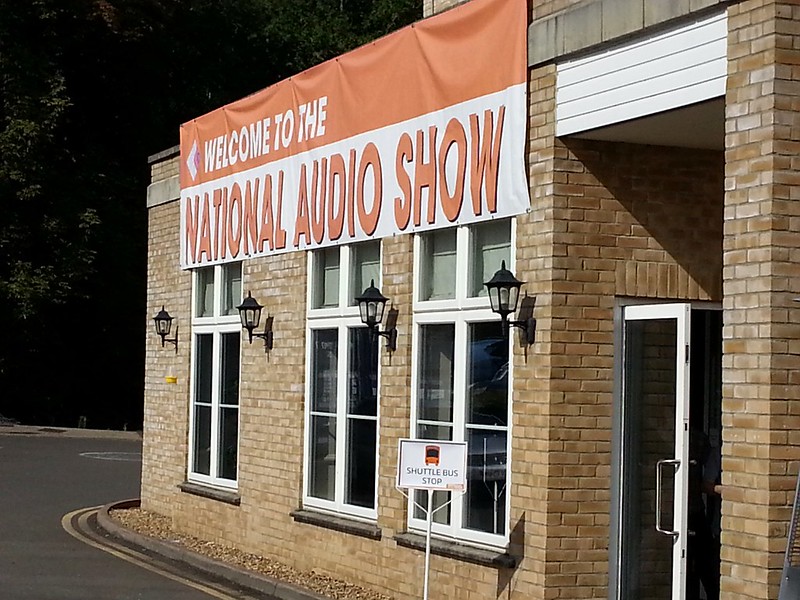 |
| Entrance to Whittlebury Hall for showgoers |
There's a big grass car park (or you can use a shuttle bus from Milton Keynes station), a 5 minute walk from the show entrance and the show is held over 2 floors, with rooms spreading out from a central courtyard where a BBQ was available most of the day. The rooms range from something like a typical living room size up to some very large conference / dining rooms. As is typical of these shows, the rooms don't contain much in the way of soft furnishings, so empty echoey rooms are always going to be a challenge. Lots of banners in evidence and some attempts at treating the rooms with columns and panels.
Attendance - having not been to this show before, I can't say if it was busy or not, compared to previous years. There were around a maximum of 40 rooms on offer, in addition to large rooms with "stalls" for accessories, and the very large "Headzone" area for headphones and associated amps. Some of the rooms we had to go back to, in order to get a seat, some were quiet and some (the ticket only music / talks / demos) were sold out all day. The corridors were reasonably busy between 11:30 and 15:00 on Saturday, much quieter after that. We arrived at 11:30 and there were some punters leaving already. The usual suspects were present - middle to later years males, but quiet a few females too, and a smattering of kids (including my own).
Also worth noting that some of the 40 rooms were very large, but contained small systems playing in one area and then lots and lots of kit on display - to be honest, if you're a vendor who wants to go this way, better to get a room for the static display and a smaller room for the small system to play in - in these vast rooms they're essentially lost (although, there was one exception to this - see later). Because of this, I would say there's probably more like 30 rooms to listen to.
What of the rooms and systems? Well, I did find some gems, and will say below which I enjoyed most, but didn't get to all the rooms, so may have missed something better.
Headzone
 |
| The very large and comprehensive "Headzone" - a really good feature of the show |
Anyway, I listened to a few examples that were of interest to me, but there are many here that really aren't of interest either because its the same stuff as heard at other shows (i.e. Grado) or because they're too ugly, too expensive, or open backed and therefore don't fit into my typical headphone usage. My son has AKG 451s and found the Y50s to be a good upgrade - they're the same drivers but in a larger closed back design that fit over rather than on his ears. He found them to have a deeper, richer bass and therefore a more relaxed listen. Seem good value. They were using the tiny Schiit Magni 2 - a £90 amp that seems to do a really good job
Stax - I tried some that were £1895 including the amplifier. I just don't get them. Lots of detail, but its a lightweight sound that really comes across as unnatural and processed. This being a theme for me - the Oppo PM-3 Planar Magnetics playing through the HA-2 amp were very similar - synthetic sounding, plus the combo started distorting at suprisingly low volume levels. Another pair of headphones (didn't make a note of what they were) on the Chord stand with the Dave DAC exhibited the same characteristics. Maybe high end headphones just aren't my thing.
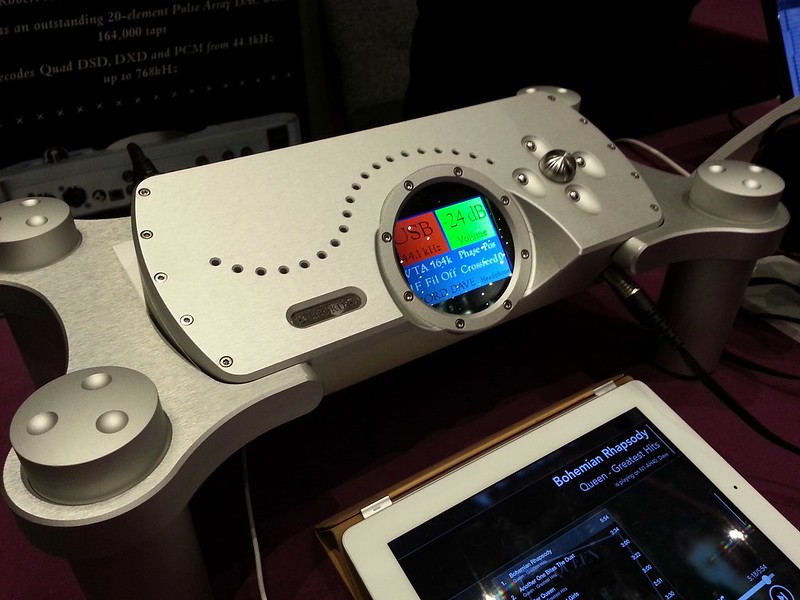 |
| Chord Dave DAC. Nice machining, dubious taste (IMHO!) |
Audioquest were exhibiting their first pair of headphones, the Nighthawk. They had 2 rigs on the go - both fed from Apple Macbooks. The first used the Chord Hugo TT as DAC and headphone amp and were ugh. Thin and synthetic again. I nearly didn't try the other pair, but glad I did - they were powered by an AudioQuest Dragonfly DAC and a £900 Trilogy 931 headphone amp, this was a really good set up - flowing music, some warmth to the sound, decent bass depth, good timing and, thank goodness, none of that synthetic sounding treble and vocals so much in evidence elsewhere. Not sure about the wisdom of pairing an £800 analogue cable with a £130 DAC and £900 amp though...
Off to the main rooms, but distracted part way along the accessories bit by a demo by Max Townsend at Townsend audio. They have some speaker "platforms" for want of a better term. Essentially, some metal plates suspended on 4 compliant towers - not sure if these towers contain springs or some kind of rubber type compound. You spec the physical size of your speaker bases and their mass when ordering - to ensure the right spec of compliance to match the mass. On top of each of a pair of PMC FACT12 speakers there was an iPad running a seizmic measuring app - one speaker was spiked to the floor, the other on one of the Townsend platforms. By jumping up and down near the speakers, the "normal" speaker analysis showed lots of disturbance and oscillations. The one on the platform continued to show a small amount of background movement. Apparently "background" seismic activity in the UK is equivalent to about 10x the movement of a tweeter dome, hence connecting the speaker to the ground makes the speaker sound "blurred", according to Townsend. The static demo was very impressive, but I'd much preferred to have heard the effect, if there's any. As usual, open minded but sceptical until I hear if for myself. Apparently PMC are fans (but weren't using the platforms in the Fanthorpe's room). The non-platformed and spiked speaker could be rocked a millimeter or so by pushing on one top corner, so it wasn't entirely convincing.
 |
| Townsend Speaker Platform |
Here we found a modest pair of speakers and a 2 seater couch along one wall of a vast room full of products on display - I think it was the Henley Designs room. Found this a bit pointless so won't comment on the sound. Here's a picture though, as the kit does look nice.
VTL / Kaiser / Vertex AQ
Eeek! Vertex AQ - not familiar with this, but this is the stuff of dedicated listening rooms methinks. Loads of cabley, mysterious box and cable lifter magic going on here. Apparently Vertex AQ (according to the room handout) are "cables, mains supplies and platforms to absorb vibration and RFI/EMI and reveal the detail and dynamics of the recording". So there you have it. In practice, it looks like this kinda mess (I'm not a cable skeptic, but I'm a touch OCD about keeping a systems as cable tidy as possible):
The rest of the system looked like this, and was a belt drive CD player feeding into VTL pre-amp , massive (£16,500 a pair) VTL monoblock power amps and Kaiser Kawero! (their punctuation, not mine):
I'm not sure quite what all that Vertex AQ stuff is doing, but its not holding back any dynamics. This is probably the fastest, most dynamic valve system I've heard. Usually valves soften and hold back a bit, but not here. Not sure about real music (that wasn't played), but a really clear pair of tracks - one percussive, the other choral - sounded very impressive in here. One of the best sounds of the show, would like to hear again with music more like the type I normally listen to.
rmb
These were playing when we were in the room. Personally, not really domestically acceptable - looking like they were built in a garage or shed. The actual finish was fine, but all that exposed plywood and screw heads doesn't do it for me. In terms of sound? Polite, gentle, inoffensive, not at all exciting. There was another, just as quirky, design in the room that looked like it might be more interesting (dome treble and mid drivers on a vertical baffle above 2x woofers in a large cabinet and facing about 45 degrees up to the ceiling). Didn't have time to go back when they were in action.
 |
| rmb |
Three rooms were in action from Cymbiosis - the highly respected LP12 fettlers and Linn / Naim dealers. Good to meet Peter at last (if only briefly, when we talked about cars). He was a busy man - particularly as long term magazine reviewer Paul Messenger was in the vicinity at the time. And there's another thing - why did Mr Messenger stand up at the back of the room? May be he's heard all this stuff before, maybe he was going back later for a proper listen (or maybe even a private listen?). But experience suggests that standing at the back of a room, next to a wall, ain't going to give a good impression. Anyway...
First up we went in the Naim 500 room, with passive Kudos Titan T808 speakers. I heard these at the Chester show earlier in the year and ended up really enjoying them (when the Naim electronics had got up to speed after their usual reluctance when new out of the box) with a Naim streamer heading things up. They've different tweeters now. Here they were being fed by a high spec LP12 (Radikal, Ekos SE, Dynavector XX, that kind of stuff) and were somewhat underwhelming - nicely detailed, but soft and too polite for my tastes. Again, due to time constraints, no time to hear with the streamer.
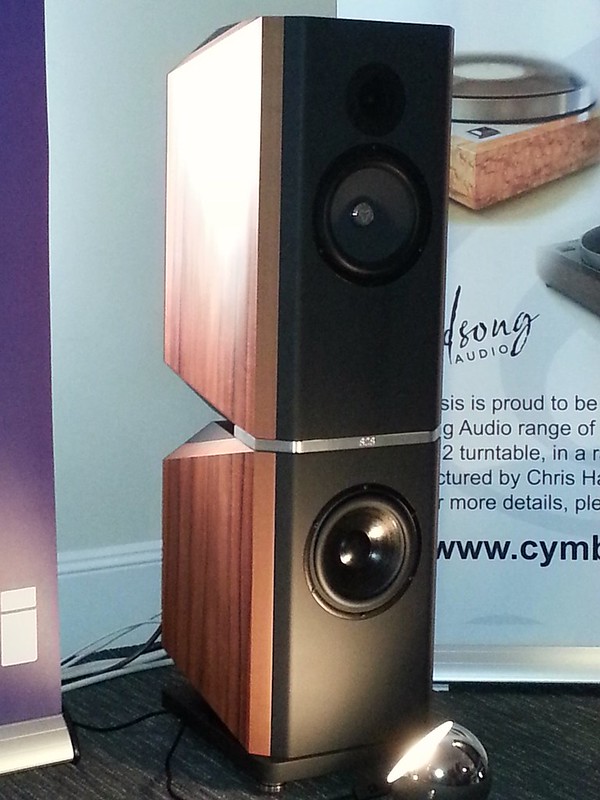 |
| Kudos Titan T808 (not sure which pair this is, I think it was in the Linn room) |
Next, trying to make a direct and quick comparison, was the Linn Exakt system, feeding another pair of Kudos T808s. In here, sources were (again) a high spec LP12 and Linn Klimax DSM/1. The DSM/1 (streamer and pre-amp) were feeding Linn Klimax Exaktboxes (crossovers, DACs, room optimisation, phase aligment etc. etc) into 6 Linn Klimax Solo mono power amps (one per driver in the speakers). With the LP12, this was making a more interesting sound than the Naim system - somewhat better in terms of a more "precise" rendition. Still soft around the edges though. Switching to the streamer confirmed my personal choice of main source - streamed digital being far more involving, exciting and foot tapping than the vinyl source. I know that's a personal choice, but here was a very stark reminder of why I went down that route. The streamer didn't add any harshness, it just added so much more pace, dynamics and detail. This is sounding good, but I don't think quite as good as the passive Naim system at Chester. Of course, a long way and a long time apart and with completely different rooms. Would like to hear them both in the same room on the same day - not the easiest thing to arrange I suppose. So, Linn Klimax Exakt with T808s proving the best so far (out performing the Kaiser / VTL system, but not massively) so far.
 |
| Linn Klimax Exakt system - there's another rack to the right with just as many boxes onboard |
In between the T808 rooms was a room with Linn Akurate DSM/1, Akurate 2200 power amp and a pair of Kudos Super 20 speakers. Here Chord were demonstrating speaker cable upgrades. During this part, I didn't have a good listening place and the room was both square and all hard surfaces - not so many absorbent banners in here. I've heard this demo before and its pretty convincing, but didn't really get into it here because the system was sounding harsh and unpleasant from where I was standing - this outweighing any changes there might have been - some of this is probably attributable to the room (my local Naimist has the same Kudos Super 20s, and they don't display any harshness at all, even with Naim). Towards the end I got a seat off-centre hear the front, the AC/DC had stopped and it sounded much better from there. They then demonstrated some SilentMount discs to put under speaker spikes, using a Fleetwood Mac track. This was interesting in the way they made the track sound like a different mix of the same song. On the face of it they provided an improvement, but it would need more listening to decide if it was better or just different. For their price, I think investment might be better elsewhere, but this was a quick listen in less than ideal circumstances.
 |
| SilentMount speaker supports - Two bonded layers of metal involved - the one that supports the spike is a "secret" alloy of some sort. Oooh :) |
 |
| Here you can see the SM-7A in proportion to the Kudos Super 20 speakers |
Audio Note
A dark room, which, in itsself is OK - I think removing distractions helps, but I also suspect that there is more to that here. Let's cover the sound first - a Yello track was playing and it sounded rather confused, less than tuneful and rather hashy/harsh. Maybe being in the front row wasn't helping here. I've heard AN systems at a few shows now, and only found them OK once - at Cranage Hall. Typically they've sounded a bit thin and not much fun. Here it was just so-so, but at least there was a bit of attack to it.
But here's the thing I really don't get about AN. And that's just the look of the gear. Now I appreciate that the way hifi looks is absolutely not the most important factor. But when we're talking about the price of kit like AN and many others, there's something in the joy of looking at something and admiring the way it looks - be it because its well crafted or how it fits into a particular decor type or by good looking components coming together to make a whole. But here, in the twilight, I don't see any of that. And I think the market for the anti-style product is probably becoming vanishingly small, very quickly. Why does every box have to be different sizes? Some black, some silver? Different styles of knobs, switches etc. And all of it very plain, just like those speaker baffle boards. Perceived VFM is very low. Coupled with this, at this show there seemed to be a particular lack of pride in the products. It was all dusty. There were greasy marks around volume controls and the turntable's tonearm was distinctly grubby. Its not a good sales technique, as far as I can see. More effort required maybe?
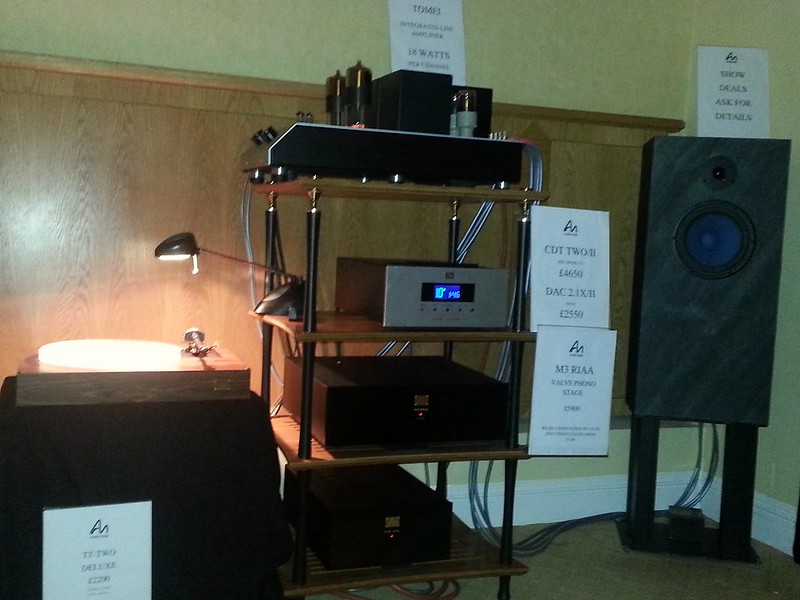 |
| Audio Note |
A reasonably large room here, but was it large enough? Not sure about all the electronics (with some of the tallest valves I've seen to date, if not the fattest) which I think were Zeta fronted by Oppo, but the speakers in here were very distinctive. They're pictured below and originate from Poland. When I was in the Orbital 306 large "patio heater" style speakers were playing. Their bass driver is in the top of the lower cylinder and points upwards, the other cylindrical ribbon driver(s?) are contained in the upper perforated cylinder. Interesting. I'm suspecting these are from a reasonably small company. They have large oval chrome badging, with "Zeta Zero" script writing engraved into them - kind of reminded me of giant dog collar tags.
This was another dark room but they brightened it up with scented candles. Nice change, no doubt some liked the scents in use and others would not enjoy, but the candle light itself was a interesting change.
These Orbital speakers, as sources, pretty much didn't really existing in the room, from a sound perspective which is an impressive achievement. The room was filled with sound and it was a kind of enveloping experience. Decent levels of tightly controlled bass, lots of detail, but the top end was (again, so many systems like this today) harsh and not pleasant to listen to for more than a few minutes. Maybe the room was too small for them, and it would be better to be sat further away. No imaging at all - if that's important to you, look elsewhere - maybe the Venus Picolla (in the other picture) would work better. Didn't hear them, so can't say. So I'd say that these are an interesting idea, probably with some potential, but also unlikely to occupy many domestic living rooms.
"Luxurious Sound For Connoisseurs" says the website. Well, I don't know what sort of connoisseurs they are referring to, but if that's luxury I'd rather rough it a bit :)
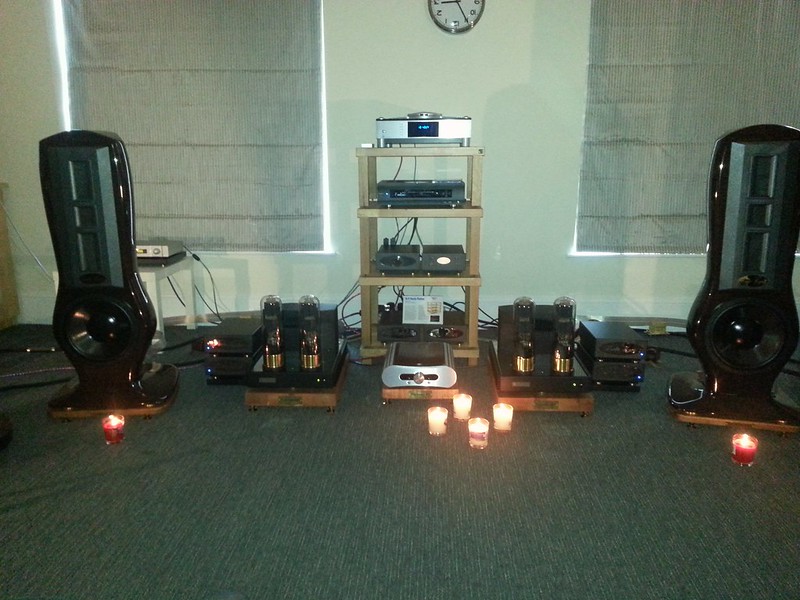 |
| Zeta Zero Room - Venus Piccola speakers & candles |
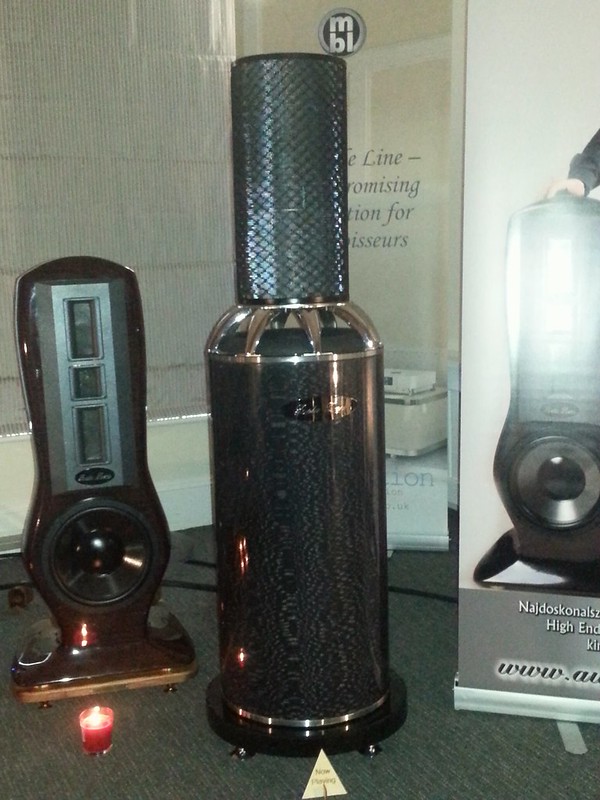 |
| Zeta Zero Orbital 360 |
Vivid brought along some of their more modest sounding speakers - perfectly suited to the size of the room they were allocated. I like the integrated look of these speakers- stands and cabinet - they look like a quality item and are very well finished. The larger of the 2 models were playing when I was in there. Sounded good, but I didn't make any particular notes on their performance - nothing objectionable, nothing exceptional. I suppose that's as much as I can say really. Not much fun being in their room though - listeners were facing a window which faced directly into a bright Sun. Just not possible to relax in those circumstances - squinting not conducive to comfortable listening. The blind just needed pulling a bit more than half the way down to make it much better. Its a lack of attention to things like this that distract somewhat. Makes for poor photos on my phone's camera too:
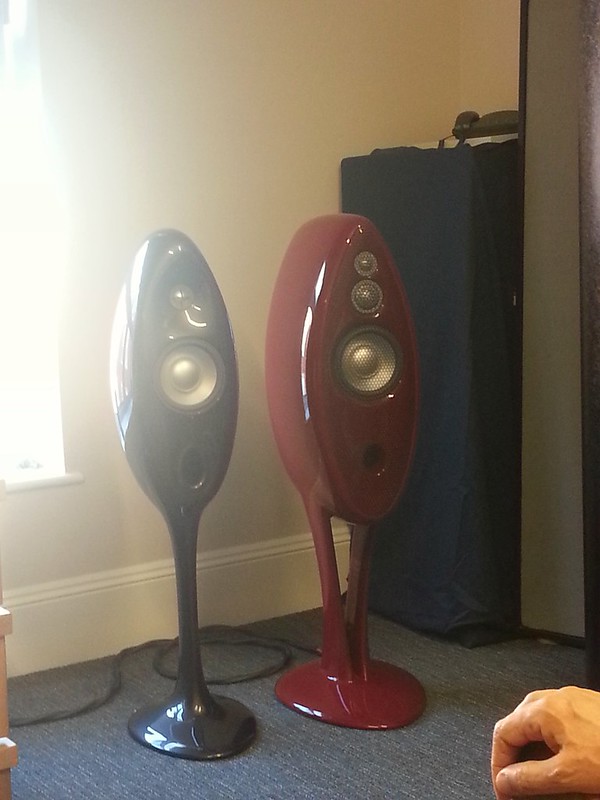 |
| Vivid (and bright light) |
AVID / Bryston / PMC / Fanthorpes
There's something about Fanthorpes as a dealer that appeals. They're active on a number of forums including CyrusUnofficial and the Wam. They're good at demos, open days, communication with customers (and potential customers), tap into some great reconditioned / ex-demo kit deals from manufacturers and promote both used kit and trade-ins. They actually display some kind of approach that is aligned to what customers might want to enjoy in terms of customer service. Radical eh? They even thought to put a banner over the window to quell the bright sunshine.
Today they had an AVID turntable playing into AVID phono stage, Bryston amps and PMC Twenty.26 speakers. Overall this system was doing a good job of playing music. I didn't get a good seat in the room, yet it was still doing well. That's the 4th time I've heard the .26 speakers and another good result. Glad PMC have finally done away with the detatched bass that I found distracting, and I think the dome midrange does a great job with vocals.
Fanthorpe's had the new Chord Dave DAC in their room too - unfortunately time restrictions meant I didn't get to hear that. Shame as it uses FPGA processors, like the Linn Klimax kit.
 |
| AVID / Bryston / PMC. Chord Dave DAC top right |
Here there were 3 pairs of active speakers on very tall, professional studio rack type stands - probably too tall really - maybe this is the one room in which standing up would've been better. The largest of these speakers are said to be the reference model in many German studios and were used by the BBC this year for the live Proms broadcast monitoring this year. A very simple digital source and pre-amp were in use.
The three models had a pretty much identical sound, just more bass extension added as we stepped up through the models. It was very much a BBC kind of sound - smooth, effortless, unexciting. Nice, but not what I'd want to live with. They're not exactly the prettiest boxes either. I'm sure there are many who will enjoy the way they sound.
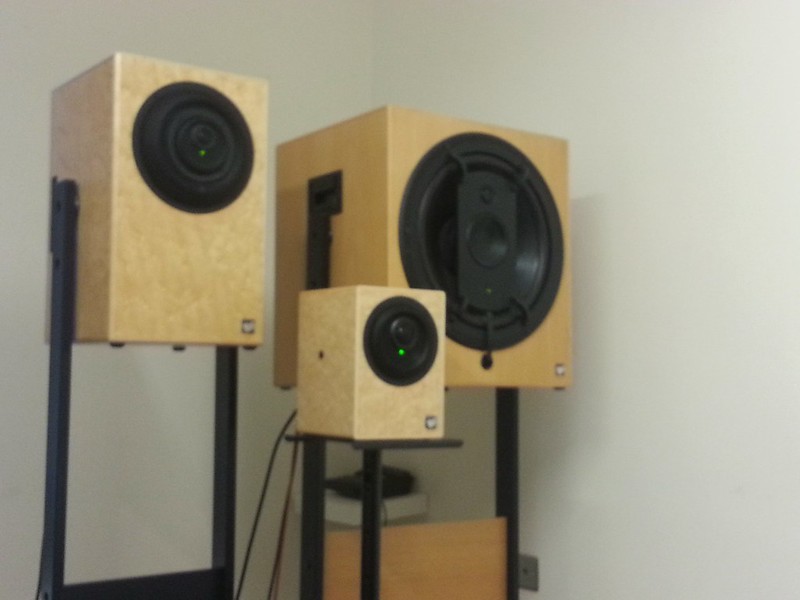 |
| Me-Geithian |
I said, right at the top, that there were some very big rooms with some very small systems and that this just didn't seem the right way to demo this kit, but there was one exception. And this was the exception. The Leema room had 2 systems in place - on walls that were at 90 degrees to each other. They were playing one system or the other for longish periods and re-arranged all the chairs to face the system in use at the time.
We went in here when the smaller system was playing - the room was pretty much empty, which is a shame.
The little system was very, very simple. It consisted of the Elements CD player, the Elements Integrated amp and some tiny standmount speakers that are near ready for production, but don't seem to have a name yet. They feature cast and machined aluminium baffles - the pair on dem appeared to have red carbon fibre sides and tops, but that might be a finish rather than their structure. They look like they might be an update on the Xen product. The DAC in the CD player was in use, rather than the one in the integrated amp.
Gregory Porter was playing when we went in. Not my type of music, generally speaking and yet it was captivating. We listened to 3 tracks on this disc, enjoying the presentation which carried weight, emotion, dynamics and detail. No massively deep bass, but these speakers went deep enough to make this a non-issue. Hoping to trip them up with music that needs a driving bass line, we tried some Yello - The Rythm Divine (with Shirley Bassey). This drove along well, the deep, lush bass lines were well portrayed and Ms Bassey was up front and centre, just as you would expect. A deeply impressive system. The tiny speakers are a somewhat more substantial £2.5k, but if you wanted a great sound in a flat, for example, where deep bass would just annoy the neighbours, this would be a good system to sample.
Nice humbug mints with toffee centres too :)
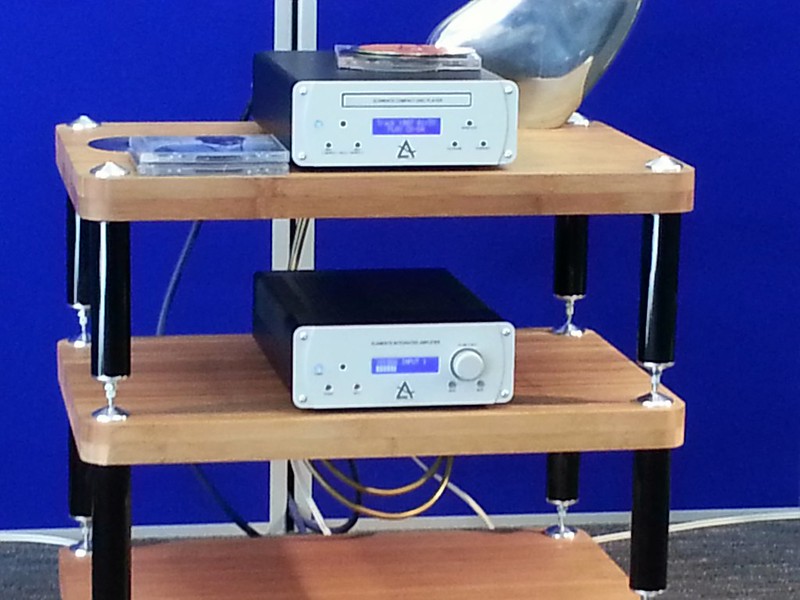 |
| Little Leemas - the Elements are compact, but not compressed. Smaller stands needed! |
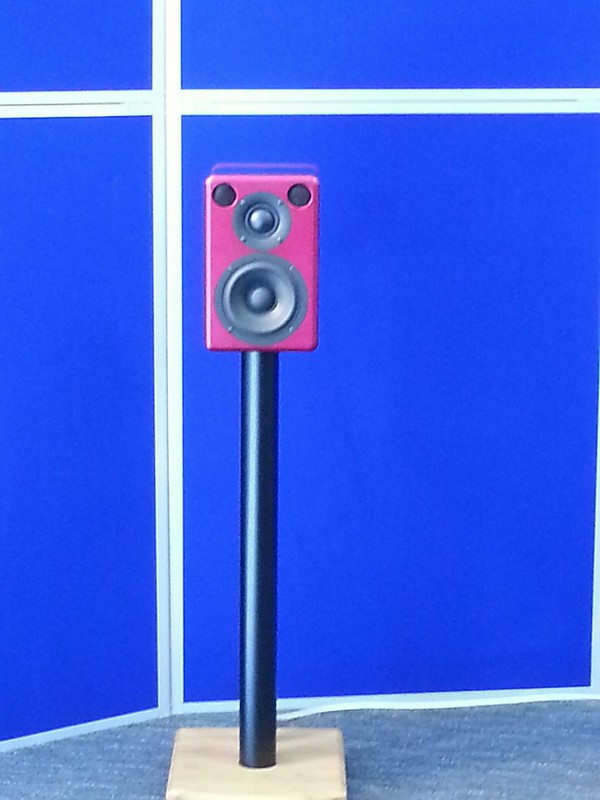 |
| Tiny speakers, big achievement |
dCS / d'Agostini / Wilson Audio
And to round off the day, we found the best sound of the show. It wasn't a walkover, the Linn Exakt / Kudos Titan system was a close contender, but this one just pipped it for me. Here we had a fully digital sourced system - no vinyl here. Data was coming from a Mac and presented by dCS streamer / clocking / pre-amp to a pair of D'Agostini monoblock amps into the imposing (and, in this case, grey) Wilson Audio Alexia speakers.
A good amount of time had been spent on the room - 3 cylindrical sound treatment thingummies standing behind each speaker, lights dimmed, plants in place and illuminated etc. etc. It was a big room but felt smaller than it was, due to the way everything was set up. Nicely done. We heard Take 5 in here (usually, that's a good reason to leave the room at a hifi show, but the sound was just too good here to do that) - fantastically clear, well separated instruments, sparkling and detailed top end with absolutely no hint of edginess nor harshness, tuneful and dynamic. A Yello track (featuring Till Bronner on a very breathy trumpet) was stunningly well delivered. The only touch of criticism was a little bass looseness, probably as part of a room node - but given all the room treatment, I would've expected that to have been dialled out. Maybe Linn SPACE as a source?
All in all, a good sounding room. But massively expensive too! The dCS kit is fabulously built too.
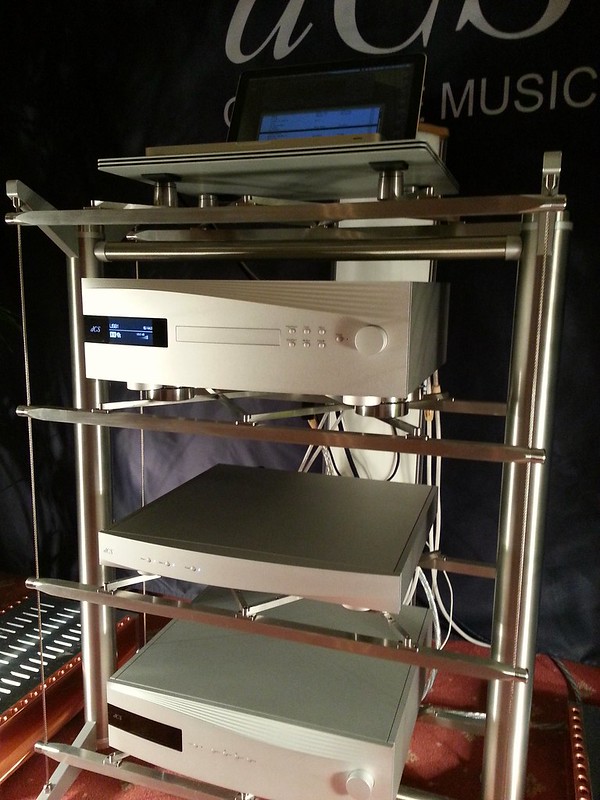 |
| dCS. Beautiful machining |
 |
| Wilson Alexia (and one of the room treatment cylinders, to the left) |
Devialet Phantom
In a very large room, a number of these interesting new products were scattered. A pair being along one wall on their very attractive dedicated stands. The Phantoms can be used on their own, in pairs or as part of a 5 channel system. They contain lots of digital type connectivity, DSP processing, power amps and speaker drivers within each cabinet. They're well built and seem to be well thought through. There's some active changes going on with the cabinets too - something to do with the way they produce bass notes.
Some are proclaiming them as the next big thing and perhaps worth ditching whole systems for. I've heard them briefly before, but wanted to give them some more time, particularly as their software seems to be developing rapidly.
To put these speakers in context, I would compare them to those flatscreen TVs you see in department stores. They're all set to "dynamic" mode for demonstrating in the shop, but try and use them at home like that and you'll get a sore head pretty quickly. Well, that's how the Phantoms sounded to me. Initially they're very impressive, particularly for such a small box. Loads of bass, lots of speed from the pair on stands. But listen for a while and they reveal themselves to be prodigious but not necessarily in control. The treble is fizzy and a little artificial, the mid-range recessed and therefore not brilliant at vocals and the bass, well there's lots of that, but it doesn't really follow a tune as such - it seems to prioritise quantity over control and quality.
Switching to a single Phantom and it made more sense - it actually sounded more musical that way. Were the stereo pair set up at the wrong distance apart, causing bass peaks and mid-range troughs? Possibly, but the discussion in the room was more about tech than music. They seem to make sense to me as a single device in a supporting role in a room rather than the main event. Take it out to the garden for the BBQ, turn it up in the kitchen at a party maybe. Could be good for action movies in a 5 channel system too, but they might miss the nuances and subtleties of a film like The Piano, for instance.
I really like the ideas behind these, but for me they've got some way to go as a quality music reproducer. I hope they continue the development and get there soon.
Oh, and my son christened them "Wubby Wubs". Sums it up nicely.
Other Rooms
A couple we dropped into briefly, including the Kralk and Magnific rooms were rather loud and harsh to listen to. Russ Andrews had racks of stuff and a small system playing so quietly at the back of the room as to be a bit pointless really. Shame we didn't have time to attend the Dragon presentation, nor other rooms such as Origin Live, Music First Audio, Teddy Pardo etc.
Generally
We met a fellow Wammer there who was attending for 2 days in order to give each room a number of visits - either to sample different music on the same system, or to hear their alternative set ups (e.g Leema) or both. I think that might be a good way to get the best out of the show and to have time to catch the presentations. I didn't enjoy the show quite as much as Cranage, but it was OK - this might've been something to do with the restricted time rather than the location or systems. There was a decent choice of (not cheap, but not rip-off) food too.
Labels:
2015,
Audio Note,
Chord,
dCS,
Devialet,
Exakt,
Kudos,
Leema,
Linn,
NAS,
National Audio Show,
PMC,
Review,
Titan,
Whittlebury,
Wilson Audio
Subscribe to:
Posts (Atom)


